|
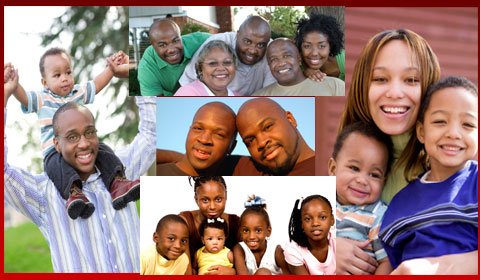
FAMILY ENRICHMENT DAY
CULTURAL RESOURCES
Wednesday, September 16, 2009
Darrin Frisby, Guest Cultural Resource Commentator, Capitol Heights, MD and
Bernice Johnson Reagon, Lectionary Team Cultural Resource Commentator
I. Etymology: Family
“Family” from circa 1400, “servants of a household,” evolved from the Latin, familia, “household,” including relatives and servants. The classical Latin sense, recorded in English in 1545, meant all within a household; “the main modern sense of ‘those connected by blood’ (whether living together or not) is first attested in 1667.” The phrase “in a family way,” meaning “pregnant,” is from 1796. Family circle is from 1809; “family man,” one devoted to wife and children, is from 1856 (earlier it meant “thief,” 1788, from family in a slang sense of “the fraternity of thieves”).1
The story of Ruth, our scripture for Family Enrichment Day, reminds us that at each moment of our lives, each of us is part of an unending circle —cycling birth, life, death, and birth again. This we all see through family. The lyrics of the song “Precious Memories” speaks of the death of a parent, and the grief of those who are left to continue. This too is part of the family life cycle.
Precious Memories
Chorus:
Precious mem'ries, how they linger
How they ever flood my soul
In the stillness of the midnight
Precious, sacred scenes unfold.
Precious father, loving mother
Fly across the lonely years
And old home scenes of my childhood
In fond memory appear.
In sad hours, when I’m lonely
The real truth of Jesus love is told
In the silence of the midnight
Precious memories flood my soul.2
II. Historical Document
The separation of families was another cruel facet of the world of slave trading. An enslaved woman’s infant was sometimes viewed as a hindrance to her sale. In one instance, a slave trader was about to start from Louisville, Kentucky with 100 slaves for New Orleans. Among them were two women who were nursing infants. The trader felt that these babies would depreciate the value of the mothers, so he sold them for one dollar each. In Nashville, another slave trader, while transporting slaves via steamboat to New Orleans, grew impatient with a mother carrying her ten month-old baby. She could not keep pace with the other slaves, so the trader snatched the infant from her arms and handed it as a gift to someone standing nearby. The mother was quickly hustled on-board as if nothing had happened.3
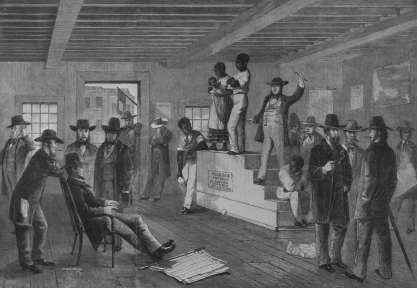
Auction Block Song
Goodby, goodby if I never ever see you anymore…
Goodby, goodby, I will meet you on the other show…
Other lines;
Pray hard, pray, if I never ever see you anymore…
Live the life, oh live the life, if I never ever see you anymore…
Sing the song, sing the song, if I never ever see you anymore…
III. August Wilson, Joe Turner’s Come and Gone
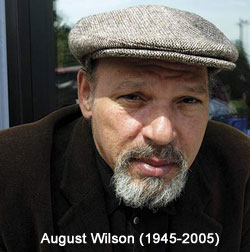 August Wilson grew up in the Hill district of Pittsburgh, Pennsylvania. His childhood experiences in this community would later inform his dramatic writings. Joe Turner’s Come and Gone is the third play in Wilson’s ten-play historical cycle, in which the playwright chronicled the African American experience in the twentieth century by devoting a play to each decade. Joe Turner’s Come and Gone represents the period from 1910 to 1920. First staged in 1984 at the Eugene O’Neil Theater in Connecticut, it opened on Broadway in 1988 to enormous critical acclaim and was voted Best New Play of the Year by the New York Drama Critics Circle. The play was inspired both by the 1978 Romare Bearden artwork Mill Hand’s Lunch Bucket (which was the first working title of the play) and the blues song “Joe Turner’s Come and Gone.” August Wilson grew up in the Hill district of Pittsburgh, Pennsylvania. His childhood experiences in this community would later inform his dramatic writings. Joe Turner’s Come and Gone is the third play in Wilson’s ten-play historical cycle, in which the playwright chronicled the African American experience in the twentieth century by devoting a play to each decade. Joe Turner’s Come and Gone represents the period from 1910 to 1920. First staged in 1984 at the Eugene O’Neil Theater in Connecticut, it opened on Broadway in 1988 to enormous critical acclaim and was voted Best New Play of the Year by the New York Drama Critics Circle. The play was inspired both by the 1978 Romare Bearden artwork Mill Hand’s Lunch Bucket (which was the first working title of the play) and the blues song “Joe Turner’s Come and Gone.”
The play concerns a group of African Americans who live in the North in a boarding house. It tells the story of Herald Loomis, an innocent black man cruelly imprisoned for seven years by white authorities. The story also concerns Joe Turner, a white plantation owner who runs a labor camp of black men jailed on false charges. Once free from the camp, Loomis sets out in search of his wife, Martha, who he hasn’t seen in ten years. He first finds his daughter, Zonia, who has been left with her grandmother by Loomis’ wife.
The majority of the play is set in a Pittsburgh boardinghouse that is run by a black couple, Seth and Bertha Holly. The year is 1911. One experiences the complexity of family, community, the search for personal identity, and the numerous stories that speak of the journeying that brought the characters together at this juncture in their lives.
Another character in the play is a white man named Rutherford Selig, who is a source of economic exploitation on different levels among blacks in the Pittsburgh community including doing work as a “finder.” For several generations, his family made their fortunes in different aspect of the slave trade and, now that slavery is outlawed, he takes fees from black people desperately seeking to be reunited to their lost families after slavery.
Loomis’ wife, Martha Pentecost, has not waited for him, but he does reunite with her in an unfortunate scene at the boarding house. The boarding house is a cross-generational community; a constructed family by necessity struggling to find a future out of a past that has violated family. The play does not end this struggling. It can be witnessed every day in America.
IV. A Personal Note from Bernice Johnson Reagon
As a child, I loved the story of Ruth and Naomi. I was so pulled by the way, while suffering a loss that would normally separate them, Ruth, the daughter-in-law said, “Do not ask me to leave you, I will go with you wherever you go, I will die where you die.” In the community I grew up in, mothers-in-law and daughters-in-law sometimes worked together although there was tension. The story of Ruth made me wonder about bonding that went beyond cultural conventions and laws.
I grew up in a family with a mother and father who had eight children. My father also had a child from an earlier relationship, and she was reared by my grandmother after the mother left. The mother left after not being able to handle what happened within our community when a girl got pregnant and the father did not marry her. Getting pregnant out of wedlock was called “messing up.” Most of the burden and cost was carried by the woman or young girl. I grew up at a time when pregnant girls were put out of church until after the baby was born and then she had to come and apologize for having sinned. The church did nothing directly to the father of the child who often was in the same congregation.
In many of our congregations, things have changed. About twenty years ago, I participated in a ceremony when my godchild was born. It was held at a Baptist church and there were eight godmothers for the child. The father was not present, and the mother was not married and had never been put out of the church. I recently saw an infant dedication where the young mother and her baby were surrounded by about fifteen people as the ceremony went forward. In both cases, family was evidenced in the people who stood and committed to being supportive of these young mothers and children. And that family circle was welcomed and supported by the congregations.
V. What Is “Family?”
Contemporary Family
Today, those of us who gather within our sanctuaries represent a broad range of family formations. There are still families with a mother, father and children as the core family unit. Often, there are also single parent families and unions with no children. There are parents married and singled who have adopted their children. There are families where the mother and father marry and create a new blended family formed from earlier unions. There are elderly couples who have chosen not to marry because of Medicaid and Social Security rules or other reasons. There are adult siblings living together, grandparents rearing their grandchildren, single parents who live with their adult children to pool resources, and unmarried partners (opposite sex and same sex) who live together. How does today’s church respond to the twenty-first century reality of family construction? A good place to begin is to revisit the story of love and commitment evidenced by Ruth in going to a strange land with her mother-in-law.
Blended Families
Cynthia Peterson writes that initially blended families were comprised of two adults and included children from one of both parties conceived in previous relationships. She notes that today, blended families might include: multicultural families, households with a combination of biological and adopted children, foster children, step-children, children reared by family members who are not their birth parents and not-traditional families.5
Washington Post columnist Courtland Milloy recently wrote a column about a special family man. At the time of this story (Feb. 2009), C. Kenneth Johnson, a member of, and supported in his work as a parent by, Shiloh Baptist Church in Washington DC, was 80 years old and retired. His story shows us the real meaning of the phrase “family enrichment.”
A Washington, DC Adoption Success Story
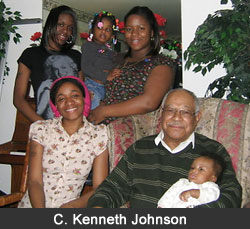 When I met C. Kenneth Johnson in 1991, he had already adopted five When I met C. Kenneth Johnson in 1991, he had already adopted five
children and was in the process of adopting 22-month-old twins. A spry 62 at the time, he was a case worker for the D.C. Office of Paternity and Child Support known for taking his work home, literally, embraced in his loving arms.
I recently visited the father extraordinaire, now a spry 80 and retired, at his home in Southeast Washington. How had he fared through the years? Just fine, thank you.
Even as evidence of cruelty toward adopted children abounds -- seven D.C. kids killed in the past eight months, their adoptive parents charged or suspected in the homicides -- Johnson stands as towering proof of a love
supreme.
He has adopted eight children since 1983. Three daughters and two grand-children still live with him. He has taken in another 144 foster children, most for a few days but some for as long as three years.
And he has done it all as a single man, too busy to look for a mate, he says, figuring that the chances of finding someone willing to help raise so many troubled children would be slim to none.
“When I look back, I can see that it was a lot of work," Johnson told me.
“But I didn't think about it that way. I just did it.”
While in his care, none of the children was neglected or abused. They did
not run away from home, skip school, commit crimes or otherwise disappear
through the cracks of a dysfunctional child welfare system.
Nothing bad to report. You might even say that when it comes to adoptions
and foster care, no news is good news -- except that if you want to know
what it really takes to help children in need, you need to know about people
like Johnson.
“He’s just an amazing man with an incredible commitment to helping our
youth,” said D.C. Council member Tommy Wells (D-Ward 6), a former social worker at the D.C. Child and Family Services Agency. “Mr. Johnson was a
foster parent for one of the youths on my caseload, and he was fearless about coming to the agency and going straight to a social worker’s desk. He’d say,
‘My child needs so-and-so.’ And whether he wanted you to sign a document
or just buy a box of his daughter’s Girl Scout cookies, he never let the government bureaucracy get in the way of providing good care for his children."
As if being an adoptive and foster parent weren’t enough, Johnson also founded the Ward 8 Tennis Council in 1985. Each summer, his organization helps more than 300 District children get tennis lessons. About 18 have attended college
on full tennis scholarships. On Feb. 28, a fundraiser will be held at Johnson’s church, Shiloh Baptist in Northwest Washington.
Oddly enough, such noble efforts to help at-risk children began with a most ignoble act committed by one of them: In March 1981, Johnson answered the doorbell at his home on Mississippi Avenue SE, and a teenage would-be robber pulled a gun and shot him in the mouth. Miraculously, Johnson survived. Given
a second chance at life, he decided to make the most of it. That he succeeded could not be more apparent.
Adopted twins Nicole and Nicola are now 19 years old. After graduating from high school, they went to work for a day-care center and plan to attend college next year: They will study child development. (Johnson, a native of New Haven, Conn., ran a state child-development agency in Pennsylvania and a Head Start program in the District before going to work for CFSA.) “That's my influence,” he said proudly of his daughters’ interest in child care.
Donna, 22 years old, adopted at 4 years of age, is a junior at the University of
the District of Columbia; Danny, 25 years old, adopted at 5 years of age, is an assistant fast-food store manager in the District; Harisha, 23 years old, adopted
at 8 years of age, is a recreation specialist for the D.C. government; Rodney,
30 years old, adopted at 9 years of age, has top-level security clearance at the Pentagon; his twin sister, Rakina, is self-employed as a marketing consultant; Quinn, 39 years old, adopted at 17 years of age, works for Lutheran Social Services.
Not long ago, Johnson’s daughters asked whether he could take in two girls –
one homeless with children, the other put out of the house by her parents.
Johnson welcomed them with open arms.
By the way, that bullet remains lodged beneath his tongue -- too close to a
major nerve for surgery. “It's like a daily reminder not to talk so much about
a problem,” he said. “Just do something about it.”6 VI. The African American Lectionary Symposia – Enriching Black Families
When the African American Lectionary was in its planning stages, pastors were surveyed concerning what they believed were the most critical issues. Strengthening families was ranked second after strengthening boys and girls. Accordingly, since it was placed online in December 2007, lectionary commentaries and cultural resource units have consistently addressed issues of importance to families.
In Fall 2008, the lectionary hosted its first symposium under the leadership of Dr. Forrest of Vanderbilt Divinity School. The symposium was titled “An Agenda for Sound Homiletics: Strengthening the Black Family.” Topics included: Economic Development for families; Sexual Development and Black Families; and Theological Approaches to Lessen Gender Imbalance in the Church. Because strengthening families is such a critical task for the African American faith community, the Spring 2009 symposium also had the same focus. The symposia will culminate in Fall 2010 with a national symposium.
VII. College Hill Church of God in Christ Family Enrichment Center Enriches Families
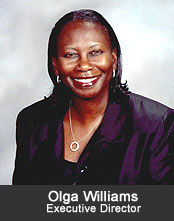 Olga Williams is executive director of a family enrichment center in Tampa, Florida. Recently, during Adoption Month, she took the opportunity to talk about her work: Olga Williams is executive director of a family enrichment center in Tampa, Florida. Recently, during Adoption Month, she took the opportunity to talk about her work:
We at The Family Enrichment Center have accomplished so much in a relatively short amount of time. Our achievements and extraordinary growth has been built by the grace of God. Combined with the efforts of a dedicated management, direct service and administrative teams; the agency has been successful in its endeavors to serve the community. Most of all, I applaud the many families who have answered the call to change the lives of children for the better. They have invited so many children into their homes through foster care and adoption and without them, our efforts would be futile, instead, they have been phenomenal.
My hope for continued success lies in this quote from the King James Bible:
"Being confident of this very thing, that he who has begun a good work in you
will continue to perform it until the day of Jesus Christ (Philippians 1:6).”
Agency’s Mission is to Draw More Attention to the Needs of Local Children in the Adoption System
Tampa, Fla. (Nov. 6, 2006)
FEC, a local faith-based, not-for-profit child-placing agency, was founded by the College Hill Church of God In Christ in 1992 to address the critical shortage of African American foster homes in Hillsborough County. The agency now manages 105 foster homes throughout Hillsborough County and provides a safe and nurturing environment to children from a variety of ethnic backgrounds.
“We are experiencing a crisis of our own right here in Tampa Bay of children who are in need of support,” said Olga S. Williams, FEC’s Executive Director. “During this month, in particular, we felt it was important to publicly reaffirm this agency’s resolve to place local children in good homes where they can get the love and care they deserve.”7
As the only licensed minority-owned and operated child-placement agency in the Southeastern United States, FEC provides care for approximately 250-350 children on a monthly basis and is responsible for placing many of the foster children in adoptive homes in Hillsborough County. During its 15-year history, the agency has touched the lives of more than 4,000 vulnerable children and families in crisis.
About The Family Enrichment Center
With a mission to address the social service and family support needs of Hillsborough County’s most vulnerable children, the Family Enrichment Center (FEC) has been recognized as one of the county’s most prolific non-profit organizations.
The agency provides services in the community that range from training for prospective foster and adoptive parents and services to people impacted by HIV/AIDS, to managing group homes for foster girls with a history of difficulty adapting to a traditional foster home environment as well as boys ages 12-17 awaiting permanent placements. In addition, the agency operates a kinship support program for grandparents who have taken on the responsibility of rearing the children of other relatives.
VIII. The Family Equality Council
The Family Equality council was formed in 1976 by a group of gay fathers. It expanded in 1986 to include lesbian mothers. It sums up the need to truly enrich families by educating our children:
The presumption of a mother and father creating a child (which may be valid for some of our children) is one with which our children will be saturated through their daily interactions with children’s books, the media, school personnel, peer discussions and exposure to various family models. It is your job as a parent, whether you identify as part of the LGBTQ community
or not, to teach your children about different family constellations.8
IX. The Black Family Reunion
We are not a problem people; we are a people with problems.
We have historic strengths; we have survived because of family.
Dorothy Height9
In 1986, Dorothy Height, then chair of The National Council of Negro Women (NCNW) became convinced that negative images of black family life were a significant problem. So she founded the annual Black Family Reunion, now a national festival. According to the NCNW website, Height wanted “a positive, culturally-based event that would celebrate the enduring strengths and traditional values of the African American family. Most importantly, this event would serve as a rallying point for government agencies, private and public sector institutions, corporations, community-based organizations and families of all ethnicities to work together on solutions to issues affecting families.”
The first Black Family Reunion Celebration was held in 1986 and featured Betty Shabazz, Coretta Scott King, The O'Jays, Lou Rawls, Alex Haley, Lerone Bennett and Arthur Ashe.
Now in its 24th year, the Black Family Reunion Celebration, located on the Washington National Mall in Washington, DC, provides a program agenda combining service, information and entertainment with workshops, issue forums, exhibits, health checks and demonstrations. The Black Family Reunion Celebration unifies the community for constructive action in the face of national concerns impacting the African American family in education, economic development, health and employment. Most importantly, the event serves as a rallying point for government agencies, private and public sector institutions, corporations, community-based organizations and families of all ethnicities to work together on solutions to the issues affecting families.
This year the 24th Annual NCNW Black Family Reunion celebration will be
held on the Washington DC Mall, September 12-13, 2009.9
Notes
1. “Family.” Online Etymology Dictionary. Online location: http://www.etymonline.com/index.php?term=family accessed 4 March 2009
2. “Precious Memories.” Gospel hymn. Adapted and arranged by Roberta Martin and Georgia Jones. Original composition by J.B. Wright.
3. Pylant, James. “Slavery Separated Families.” The Anti-Slavery Record. Vol. I May, 1835: 51-52. Online location: Genealogy Magazine.com, http://www.genealogymagazine.com/slavsepfam.html accessed 4 March 2009
4. “Joe Turner's Come and Gone | Introduction.” eNotes.com. Online location: http://www.enotes.com/joe-turners accessed 4 March 2009
5. Petersen, Cynthia. “Types of Blended Families: The Changing Description of a Typical Family Affects the Blended Family as We Know It.” Suite101.com. Online location: http://blendedfamilies.suite101.com/article.cfm/types_of_blended_families#ixzz09GnsNER3 accessed 4 March 2009
6. Milloy, Courtland. “A D.C. Adoption Success Story.” Washington Post. 18 Feb. 2009: B1.
7. Family Enrichment Center. Online location: www.fectampa.org. accessed 4 March 2009
8. Family Equality Council. Online location: http://www.familyequality.org/ accessed 4 March 2009
9. Lewis, Jones Johnson. “Dorothy Height Quotes.” About.com: Women’s History. Online location: http://womenshistory.about.com/od/quotes/a/dorothy_height.htm accessed 4 March 2009
10. National Council of Negro Women, Inc. Online location: http://www.ncnw.org/events/reunion.htm accessed 4 March 2009
|